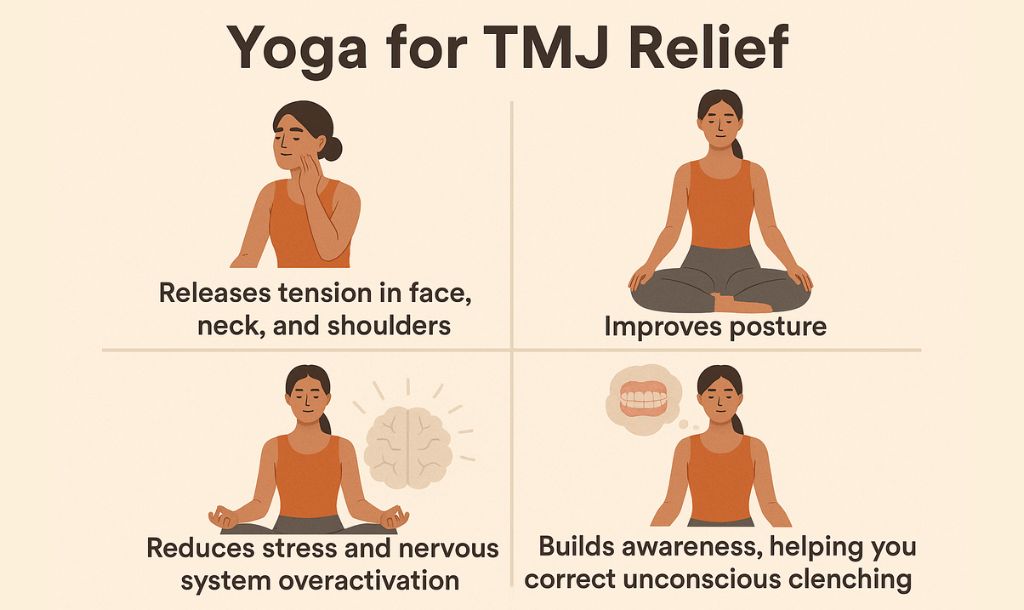What is Apanasana (Knees-to-Chest Pose)?
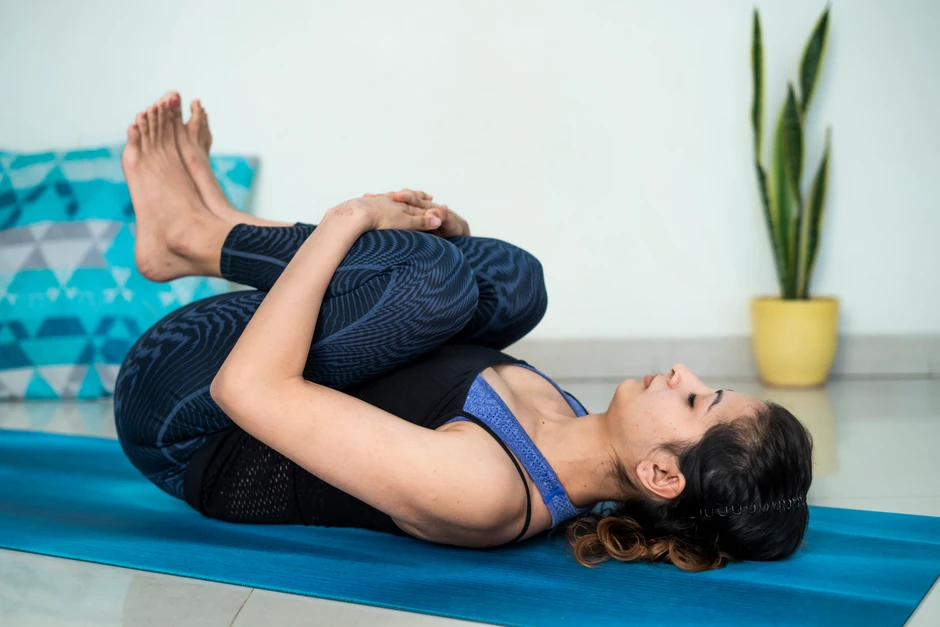
Apanasana (Knees-to-Chest Pose) is a gentle, restorative yoga posture where you lie on your back and gently hug both knees toward your chest, releasing lower back tension, calming the nervous system, and promoting deep relaxation. Pronounced "ah-pah-NAH-suh-nuh," this beginner-friendly pose is one of yoga's most soothing and accessible poses, perfect for warm-ups, cool-downs, or bedtime practice.
About Apanasana: Overview & Meaning of Knees to Chest Pose
In Sanskrit, Apana refers to the downward flow of energy in the body that supports elimination and grounding, while Asana means pose or posture. Together, Apanasana translates to the “Pose of Downward-Moving Energy.” This gentle knees-to-chest position lightly compresses the lower abdomen, which helps calm the nervous system, stimulate digestion, and support physical and mental relaxation.
Apanasana has its roots in traditional Hatha Yoga, where gentle, repetitive movements were used to warm up the joints and calm the mind. In modern yoga, the Knees-to-Chest pose has become a staple across styles like Hatha, Iyengar, Restorative, and Yin Yoga because it’s simple, safe, and deeply soothing. Teachers often introduce it at the start or end of a class to relieve back tension, quiet the mind, and reconnect breath with movement.
Physically, Apanasana provides gentle decompression for the lower back and spine, loosening tight muscles from prolonged sitting or stress. It lightly engages the hip flexors and core, while allowing the shoulders and upper back to soften into the mat. The mild pressure on the abdomen helps massage internal organs, supporting digestion and circulation. As you breathe deeply in this reclined position, your body naturally activates the parasympathetic nervous system, which slows the heart rate and encourages full relaxation — grounding both body and mind.
At a Glance
- Sanskrit Name: अपानासन (Apanasana)
- Pronunciation: ah-pah-NAH-suh-nuh
- English Names: Knees-to-Chest Pose, Apana Pose (gentle variation of Wind-Relieving)
- Pose Type: Supine, restorative, spinal release
- Level: Beginner (accessible to everyone)
- Duration: 30 seconds to 10 minutes
- Main Benefits: Lower back release, stress relief, gentle hip opening, nervous-system calming
Apanasana vs. Pavanmuktasana: Understanding the Difference
While often confused with Pavanmuktasana, here’s how Apanasana differs from it:
Benefits of Apanasana (Knees-to-Chest Pose)
By combining gentle spinal release with calming breath, Apanasana restores balance to both the body and mind. This pose is perfect for anyone seeking relaxation, pain relief, or emotional grounding after a long day of sitting or stress.
Physical Benefits
- Releases lower back tension: Gentle traction decompresses the lumbar spine and eases tightness from sitting or standing.
- Stretches hip flexors and glutes: Reduces stiffness and improves mobility in the hips.
- Improves spinal flexibility: Encourages subtle movement through each vertebra.
- Relieves mild sciatica symptoms: Creates space in the lower back, easing nerve pressure (when done gently).
- Massages abdominal organs: Soft compression supports digestion and elimination.
- Eases menstrual cramps: Light pressure in the lower abdomen relaxes pelvic muscles.
- Supports pelvic floor health: Gentle engagement strengthens without strain.
- Reduces muscle tension: Promotes a full-body release response.
- Improves posture: Counteracts slouching by lengthening the lower back.
Mental & Emotional Benefits
- Calms the nervous system: Activates the parasympathetic “rest and digest” state.
- Reduces stress and anxiety: The fetal-like shape creates a sense of comfort and safety.
- Improves sleep quality: Ideal as part of a bedtime or restorative routine.
- Encourages emotional release: Hips and lower back often store unprocessed tension.
- Grounds restless energy: Excellent for calming an overactive mind.
- Builds body awareness: Invites slow, mindful observation of sensation and breath.
- Cultivates self-compassion: This accessible pose helps you reconnect with gentleness.
Therapeutic Applications
- Lower back pain: Gentle traction provides relief for chronic stiffness.
- Hip tightness: Counteracts the effects of long sitting hours.
- Mild sciatica: Encourages safe, supported mobility.
- Digestive issues: Stimulates natural peristalsis and relieves bloating.
- Menstrual discomfort: Relieves cramps and lower abdominal heaviness.
- Prenatal comfort (first trimester): Eases back strain when practiced gently.
- Anxiety or insomnia: Perfect bedtime reset pose.
- Fatigue or burnout: Helps restore calm and energy balance.
- Trauma-sensitive yoga: Creates a grounding sense of control and safety.
Note: Always consult a healthcare provider if you have spinal, abdominal, or post-surgical conditions. Yoga complements treatment but should not replace it.
To practice safely and reap maximum benefits, book a free 1-on-1 session today!
How to Do Apanasana (Knees-to-Chest Pose): Step-by-Step Guide
Apanasana (Knees-to-Chest Pose) is one of the most soothing ways to relax your back and calm your body. It’s best practiced on a soft mat, rug, or even your bed — anytime you need grounding or gentle release.
Part 1: Preparing for the Pose
- No need for an empty stomach — this pose is restorative, not digestive.
- Wear loose, comfortable clothing and lie on a soft surface.
- Ideal anytime of day: in the morning to awaken your spine or before bed to unwind.
- Optional props: blanket under head or strap around thighs for support.
1. Corpse Pose (Savasana)
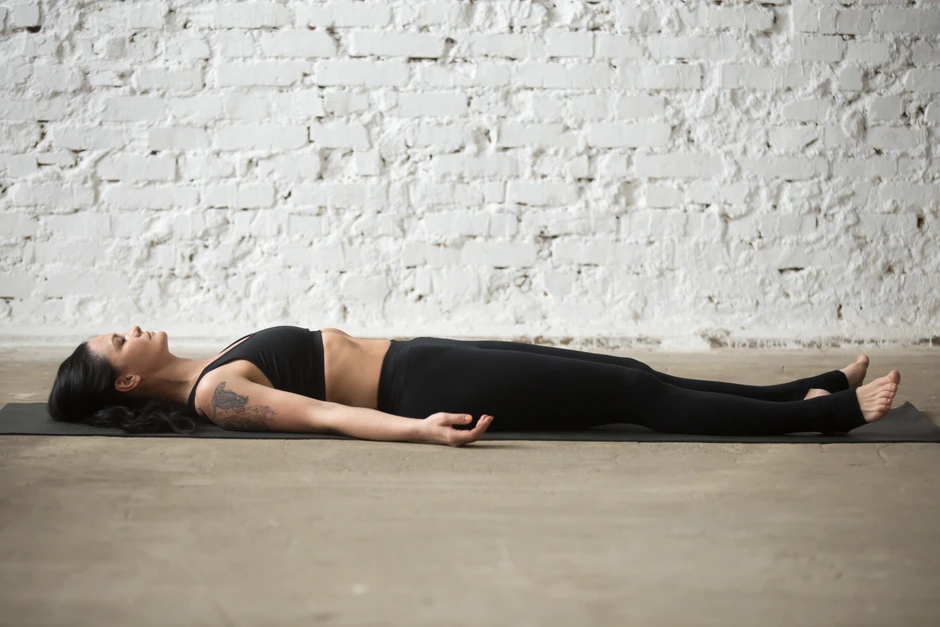
Promotes full-body relaxation and mental stillness before starting your yoga practice.
- Lie flat on your back with legs extended and arms relaxed by your sides.
- Close your eyes and soften your jaw and shoulders.
- Breathe naturally, letting your body feel heavy and grounded for 1–2 minutes.
2. Ankle and Knee Circles
Gently warms up and lubricates the joints, improving mobility before deeper poses.
- Lie on your back with knees bent and feet lifted slightly off the mat.
- Slowly rotate your ankles and knees in small circles, first clockwise, then counterclockwise.
- Keep movements smooth and coordinated with your breath for 30–60 seconds.
3. Single-Leg Knee-to-Chest Stretch
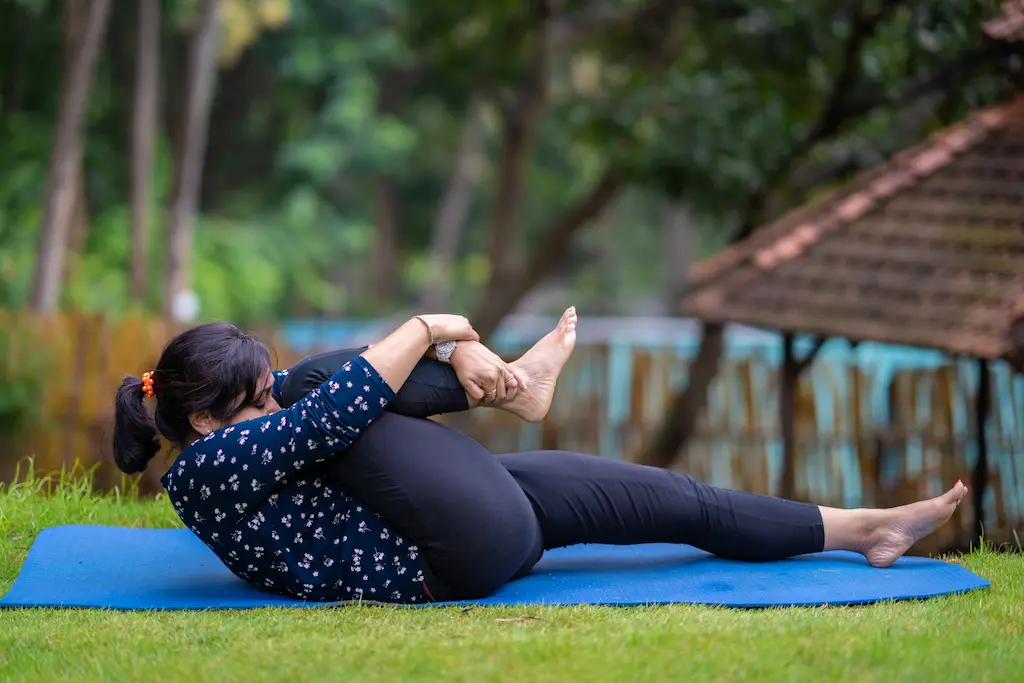
Loosens tight hip flexors and lower back muscles, preparing for Apanasana.
- Lie on your back and bend your right knee toward your chest.
- Hold your shin or the back of your thigh with both hands.
- Keep your left leg extended and grounded; switch sides after 3–5 breaths.
Part 2: How to do Apanasana (Knees-to-Chest Pose): Step-by-Step Instructions
Basic Apanasa
- Lie flat on your back with legs extended and arms by your sides. Relax your shoulders and take a few slow, deep breaths to settle your body. Inhale deeply through your nose, exhale through your mouth.
- Gently press your lower back toward the mat to create a neutral spine. Feel your pelvis and shoulders relax evenly. Soft exhale, grounding the back body into the floor.
- On an inhale, bend your right knee and slide your heel toward your seat. Then bring your left knee in the same way.
- Wrap your arms around your shins or place your hands below your knees. Keep elbows soft and shoulders resting on the mat. Exhale as you gently draw your knees closer.
- Keep your knees together (unlike Pavanamuktasana, where they separate). Let your lower back stay in full contact with the mat.
- Soften your face and jaw. Let gravity draw your thighs toward your chest — no forcing or pulling.
- Duration:
- Warm-up: Hold 30 seconds–1 minute.
- Gentle practice: Hold 1–3 minutes.
- Restorative: Hold 5–10 minutes with props.
- If comfortable, rock slightly side to side to massage your spine, or make small circles with your knees.
- Exhale, then release your grip and lower your feet gently to the mat. Keep knees bent and rest in this position for 2–3 breaths.
- Extend your legs and rest fully, allowing your body to absorb the calm.
Restorative Apanasana
For deep relaxation or bedtime:
- Place a bolster or folded blanket under your hips for support.
- Use a strap around your thighs to hold your knees gently.
- Rest a small cushion under your head and neck.
- Hold for 5–10 minutes, eyes closed, breathing softly.
You should feel your lower back release, your belly relax, and your mind slow down — a perfect pose for emotional grounding or sleep preparation.
Common Mistakes & Fixes
- Pulling too hard causes strain instead of release. Hold softly and let gravity do the work.
- Lifting head or shoulders reduces the grounding effect. Keep the back of the head and shoulders on the mat.
- Holding the breath creates tension. Maintain steady, slow breathing.
To learn correct alignment, safe variations, and breathing techniques tailored to your needs, book a free 1-on-1 session today!
Apanasana Variations
No matter your flexibility or experience, there’s a version of Apanasana (Knees-to-Chest Pose) that fits your body. These modifications make the pose accessible for beginners, therapeutic for recovery, and even strengthening for advanced practitioners.
Single-Leg Variations
1. Ardha Apanasana (Half Knees-to-Chest Pose)
Ideal for beginners or uneven hip tightness — releases one side of the lower back safely.
- Lie on your back and extend your left leg along the mat.
- On an exhale, draw your right knee toward your chest.
- Hold the shin or back of the thigh gently.
- Keep your extended leg active and grounded; switch sides after a few breaths.
2. Crossed-Ankle Variation
Great for tight outer hips or IT band release — adds a gentle twist and lateral stretch.
- Bring your right knee toward your chest and cross the right ankle over your left thigh (figure-4 shape).
- Draw your left thigh gently toward your body.
- Hold the back of your left thigh or use a strap.
- Keep shoulders relaxed and switch sides.
3. Alternating Dynamic Apanasana
Perfect morning warm-up — mobilizes the hips and improves circulation.
- Lie on your back and bring one knee toward your chest as you exhale.
- Inhale to release that leg, exhale to draw the other in.
- Move slowly with your breath for 10–20 repetitions.
- End with both knees drawn in for a few deep breaths.
Restorative & Therapeutic Variations
4. Supported Apanasana with Bolster
Best for deep relaxation or back tension — offers gentle decompression with no effort.
- Place a bolster or folded blankets under your hips to elevate them 3–6 inches.
- Bring both knees toward your chest and clasp your legs softly.
- Close your eyes and breathe deeply for 5–10 minutes.
- Let gravity do the work — this version is excellent before bed.
5. Strap-Assisted Apanasana
Great for longer holds or limited grip strength — reduces strain on arms and shoulders.
- Loop a yoga strap around your thighs, just above the knees.
- Gently hug your knees toward your chest, resting your arms.
- Maintain a relaxed grip and deep belly breathing.
- Perfect for restorative yoga or meditation preparation.
6. Wall-Supported Apanasana
Safe and stable — ideal for seniors, pregnancy (1st trimester), or balance issues.
- Lie on your back about a foot from the wall.
- Place both feet on the wall with knees bent at 90 degrees.
- Bring one knee toward your chest while the other stays on the wall.
- Switch sides, maintaining soft breathing and steady support.
7. Rocking Apanasana
Excellent for spinal massage and relaxation — soothes both muscles and nerves.
- From the basic pose, hug your knees and gently rock side to side.
- Keep your movements small and controlled.
- Let the back of your ribs and hips roll across the mat evenly.
- Great as a transition into Savasana or bedtime routine.
Active & Strengthening Variations
8. Lifted Head Variation
Builds gentle core strength while supporting spinal health.
- From Apanasana, lift your head and shoulders slightly toward your knees.
- Engage your core while keeping the lower back grounded.
- Hold for 5–10 slow breaths, then release.
- Avoid if you have neck strain or injury.
9. Side-to-Side Stretch
Targets obliques and side body — relieves tightness from sitting.
- From basic Apanasana, keep knees together and drop them gently toward one side.
- Keep the opposite shoulder grounded.
- Breathe into your side ribs for 30–60 seconds, then switch sides.
- Move slowly to protect the lower back.
10. Extended Leg Variation
Combines hamstring stretch with hip release — enhances flexibility and balance.
- Hug one knee to your chest while extending the opposite leg toward the ceiling.
- Keep both feet flexed and core engaged.
- Hold for 5–10 breaths, then switch sides.
- Avoid forcing either leg; let the breath deepen the stretch.
Apanasana (Knees-to-Chest Pose) Precautions & Contraindications
While Apanasana (Knees-to-Chest Pose) is one of the gentlest and safest yoga poses, mindful practice is key — especially if you have injuries, are pregnant, or recovering from surgery.
Avoid Apanasana If You Have:
- Recent abdominal or spinal surgery: Wait for medical clearance (usually 6–12 weeks).
- Active hernia or acute abdominal inflammation (e.g., appendicitis, peritonitis).
- Late-stage pregnancy (2nd or 3rd trimester): Lying flat may compress blood flow.
- Acute herniated disc or severe osteoporosis: Spinal flexion may aggravate symptoms.
- Hip replacement: Avoid unless cleared by your surgeon.
- Fractured ribs or vertebrae: Rest until fully healed.
Practice Gently or with Modifications in case of:
- Pregnancy (First Trimester): Practice Ardha Apanasana (one leg at a time), keep compression light (30–60 seconds), elevate the upper body slightly, and avoid supine versions after the first trimester.
- Chronic Lower Back Pain: Start with the single-leg version, use a folded blanket under the hips for support, and stop immediately if pain increases.
- Knee or Hip Arthritis: Modify by holding behind the thighs, keeping knees slightly apart, and using pillows or straps for comfort.
- High Blood Pressure (Controlled): Maintain smooth breathing, keep your head on the mat, and relax the eyes and face.
- Acid Reflux or GERD: Avoid practicing after meals and elevate the upper body with a bolster or pillow.
- Menstruation or Mild Cramps: Practice gently, shorten hold time, and avoid long compressions if discomfort arises.
- Postpartum or C-Section Recovery: Wait 6–8 weeks or until cleared by a doctor, begin with a single-leg or chair variation, and keep compression very light.
General Safety Guidelines

- Be gentle — let time and gravity open your body.
- Never force your knees closer; a mild sensation is enough.
- Breathe continuously — holding breath adds tension.
- Move slowly in and out of the pose.
- Use props like blankets, straps, or bolsters as needed.
- Keep your lower back grounded — don’t arch or lift the head.
- If unsure, start with one leg at a time.
If you’re unsure, work with a certified yoga coach. Book your free 1-on-1 session today!
Apanasana: Related Yoga Poses
Enhance your Apanasana (Knees-to-Chest Pose) practice by pairing it with these poses:
1. Reclined Butterfly Pose (Supta Baddha Konasana)
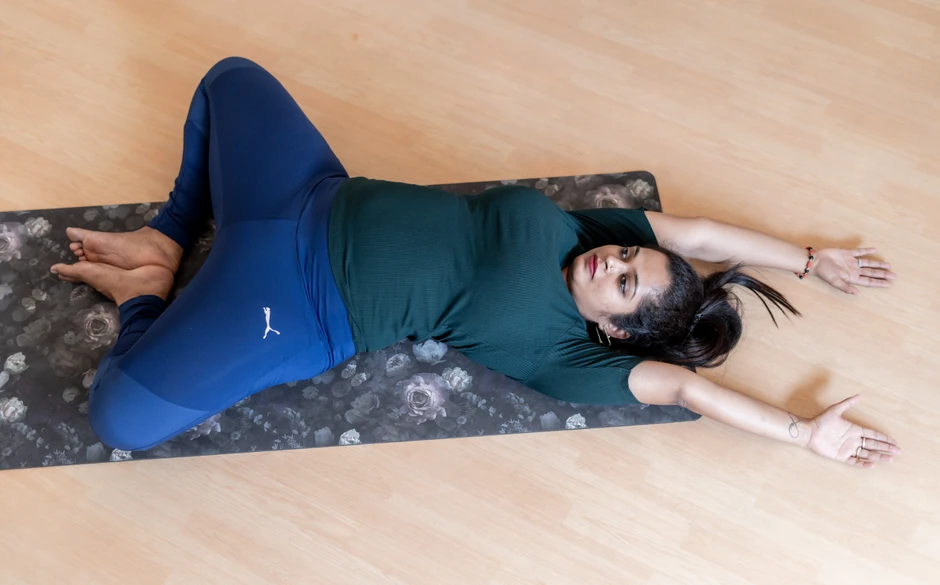
Gently opens the inner thighs and hips, promoting relaxation and circulation.
- Lie on your back and bring the soles of your feet together.
- Let your knees fall open to the sides, supported by blocks or cushions.
- Rest your arms beside you and breathe slowly into the hips for 1–3 minutes.
2. Wind-Relieving Pose (Pavanamuktasana)

Improves digestion and relieves gas by compressing the abdomen.
- Lie on your back and draw one or both knees toward your chest.
- Hug them gently with both arms, keeping your shoulders relaxed.
- Take deep breaths, feeling the abdomen expand and contract with each inhale and exhale.
3. Happy Baby Pose (Ananda Balasana)
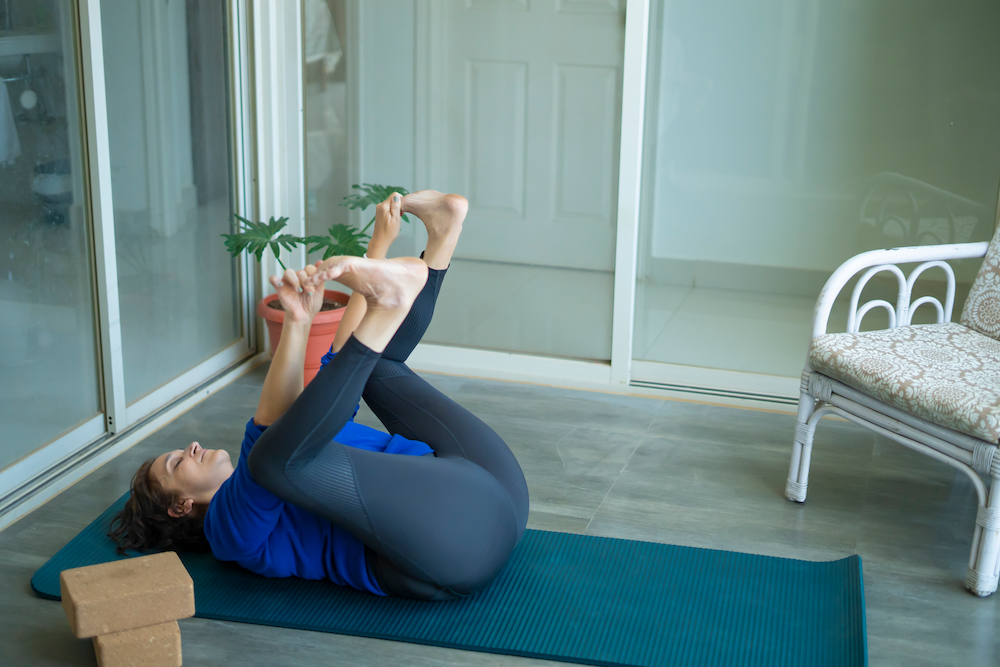
Deeply opens the hips and relieves lower back tension while calming the mind.
- Lie on your back and bend your knees toward your armpits.
- Hold the outer edges of your feet, keeping your ankles above your knees.
- Relax your shoulders and gently rock side to side for a few breaths.
4. Reclined Spinal Twist (Supta Matsyendrasana)
Stretches the spine and releases tension in the lower back and shoulders.
- Lie on your back, bend your knees, and drop them to one side.
- Extend your opposite arm out to shoulder height and look toward it.
- Keep both shoulders grounded and breathe deeply for 30–60 seconds, then switch sides.
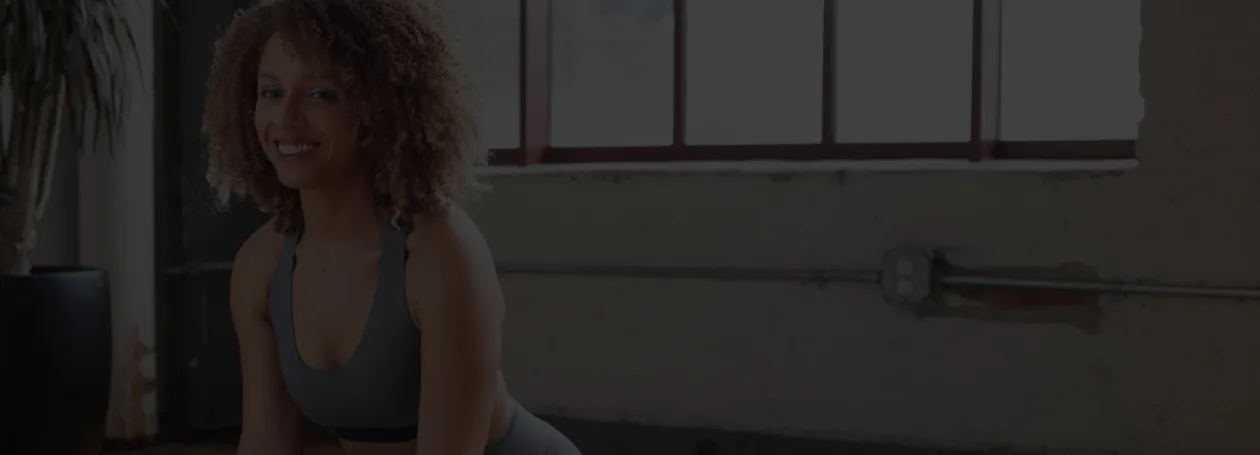
Enjoy a Free 1-on-1 Session with a Coach!
Receive personalized guidance tailored to your unique fitness goals, live with a dedicated coach—no credit card required.
Frequently Asked Questions
Apanasana is excellent for releasing lower back tension, relaxing tight hips, and calming the nervous system. It’s especially beneficial for stress relief, improving sleep, easing menstrual cramps, and supporting gentle digestion. The pose’s soft, hugging motion helps your body and mind unwind, making it a favorite for restorative yoga and bedtime routines.
Hold Apanasana for 30 seconds to 10 minutes, depending on your goal.
- Warm-up: 30 seconds–1 minute
- Gentle release: 1–3 minutes
- Restorative/Bedtime: 3–10 minutes
Longer holds with slow breathing deepen relaxation and relieve back tightness. Always stay within comfort — this pose is about ease, not effort.
Yes! You can do this pose with modifications during the first trimester only. Practice Ardha Apanasana (one leg at a time), avoid strong compression, and elevate your upper body with a bolster. After the first trimester, switch to side-lying or wall-supported poses to maintain safety and comfort.
To practice yoga with maximum safety during pregnancy, book a free 1-on-1 session today!
Absolutely. Apanasana is one of the safest and most effective poses for relieving lower back tension. It creates gentle traction in the lumbar spine, relaxes tight hip flexors, and eases sciatic discomfort. Begin slowly and breathe deeply — even one minute can bring noticeable relief when practiced daily.
Anytime! Apanasana fits easily into morning, evening, or bedtime routines.
- Morning: Gently awakens the spine.
- Post-work: Relieves tension from sitting.
- Before bed: Promotes deep relaxation.
There’s no wrong time — just breathe, soften, and enjoy the grounding calm it brings.
Yes! Apanasana is one of the best bedtime poses. Its gentle rocking motion and deep belly breathing activate your body’s “rest-and-digest” response, helping release daily stress and tension. Hold the pose for 3–5 minutes before bed to relax your spine and prepare your mind for restful sleep.



.webp)
%20(7).jpg)
